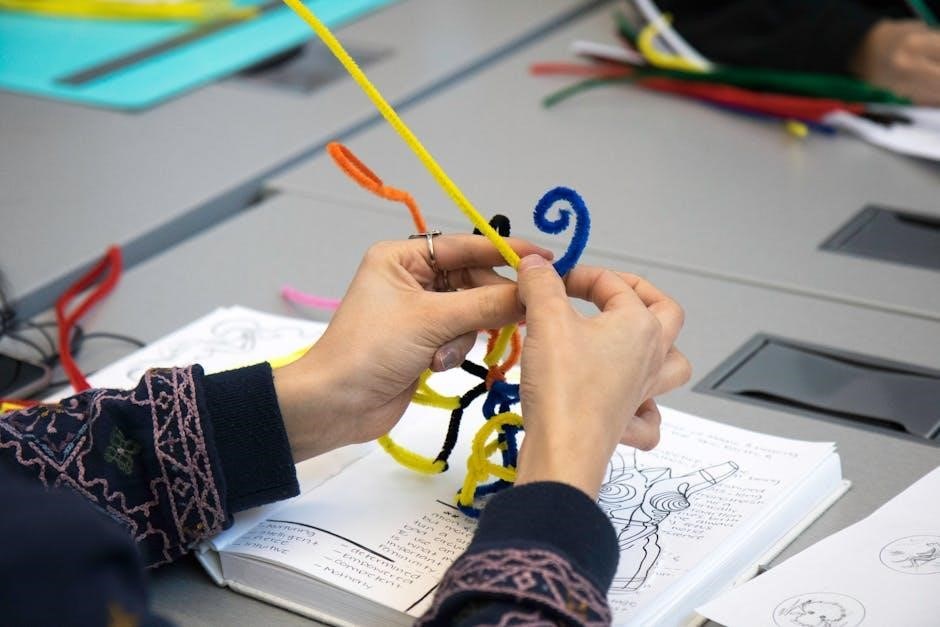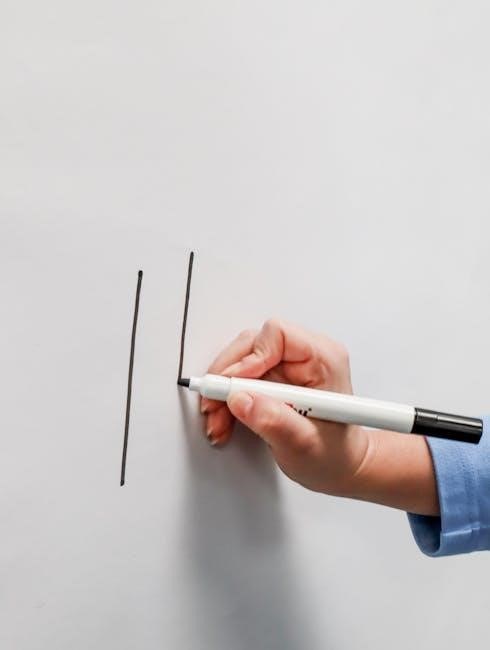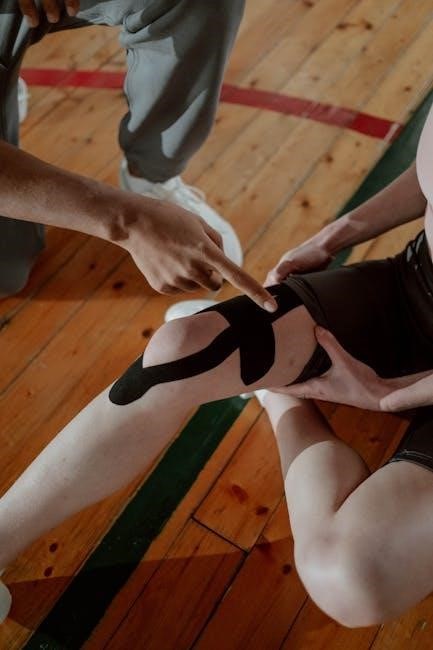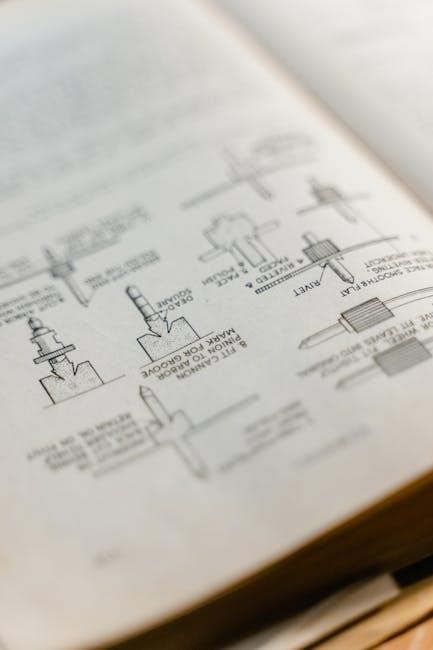Teeter Hang Ups inversion tables provide spinal traction benefits, aiding back pain relief. Since the 80s, models like EP-550 and EP-650 offer effective inversion therapy, often with instructional DVDs for safe use. They’re known for durability and ease of assembly.
1.1 Overview of the Teeter Hang Ups Inversion Table
The Teeter Hang Ups inversion table is a highly-regarded tool for spinal traction and inversion therapy, designed to relieve back pain, improve posture, and enhance flexibility. Known for its durability and ease of use, the table comes in various models, such as the EP-550 and EP-650, which are popular for their precision engineering and user-friendly features. The table allows users to invert at controlled angles, leveraging gravity to decompress the spine and relax tense muscles. It is often recommended for individuals with chronic back pain, sciatica, or disc-related issues. The device is typically preassembled, making setup straightforward, and comes with an instructional manual and DVD to guide users through safe and effective inversion practices. While some users find the initial experience of inversion uncomfortable, many report significant relief from back pain and improved mobility over time. The Teeter Hang Ups inversion table is a versatile and effective addition to a home or clinical rehabilitation regimen, offering a natural approach to spinal health and wellness.
1.2 History and Development of Inversion Therapy
Inversion therapy has its roots in ancient practices, with evidence of gravitational traction being used in yoga and gymnastics for centuries. The modern concept of inversion tables, however, emerged in the 1960s when Roger Teeter pioneered the first inversion table to address his own chronic back pain. His innovative design combined gravitational forces with spinal traction, laying the groundwork for contemporary inversion therapy. Over the years, inversion tables have evolved to include adjustable features, sturdier materials, and safety mechanisms, making them more accessible and user-friendly. The development of models like the Teeter Hang Ups EP-550 and EP-650 reflects advancements in engineering and user feedback, ensuring a smoother and more controlled inversion experience. Despite initial skepticism, clinical studies from the 1980s began to validate the benefits of inversion therapy, particularly for conditions like sciatica and disc-related pain. Today, inversion therapy is widely recognized as a complementary approach to spinal health, with Teeter Hang Ups leading the market in innovation and quality. The therapy has transitioned from a niche treatment to a mainstream practice, embraced by both healthcare professionals and home users for its potential to alleviate back pain and improve overall well-being.

Safety Guidelines for Using Teeter Hang Ups
Always read the manual thoroughly and inspect the equipment before use. Ensure proper settings to avoid injury. Individuals with hypertension, glaucoma, or spinal conditions should avoid inversion therapy. Consult a healthcare professional before starting.
2.1 Essential Pre-Use Safety Checks
Before using your Teeter Hang Ups inversion table, perform a thorough inspection to ensure safe operation. Check all bolts, hinges, and components for tightness and proper alignment. Verify that the table is placed on a level, stable surface to prevent tipping. Inspect the ankle locking system, tether strap, and hand grips for any signs of wear or damage. Ensure the inversion table is fully assembled according to the instruction manual and that no parts are missing or loose. Familiarize yourself with the components, such as the A-frame, main shaft, and adjustable features, to ensure they function correctly. Always review the safety guidelines and contraindications in the manual before your first use. If you notice any damage or malfunction, do not use the inversion table until it is repaired. Proper pre-use checks help minimize risks and ensure a safe inversion experience.
2.2 Contraindications for Inversion Therapy
Before using a Teeter Hang Ups inversion table, it is crucial to understand the contraindications to avoid potential harm. Inversion therapy is not suitable for individuals with certain medical conditions. For example, people with hypertension should avoid inversion due to significant increases in blood pressure during use. Those with glaucoma or other ocular pathologies are also at risk, as inversion can elevate ophthalmic artery pressure. Pregnant women, individuals with recent fractures, or those with osteoporosis should not use the inversion table, as it may exacerbate their condition. Additionally, inversion therapy is contraindicated for people with hiatal hernias, spinal hypermobility, or severe vascular compromise. Patients with GERD may experience discomfort due to the inverted position. It is essential to consult a healthcare professional before starting inversion therapy, especially if you have any underlying health conditions. Always adhere to the guidelines provided in the instruction manual and prioritize your safety to avoid complications.
2.3 Emergency Procedures and First Aid

In the event of an emergency while using a Teeter Hang Ups inversion table, it is essential to act quickly and carefully to ensure the user’s safety. If someone experiences dizziness, nausea, or discomfort, immediately stop the session and return to an upright position. To release the user, carefully lower the table to its starting position or manually assist them in exiting the device. If the user loses consciousness or experiences severe pain, call emergency services immediately. Provide first aid by ensuring the person is in a comfortable position and monitoring their vital signs until professional help arrives.
Preventing emergencies is equally important. Always follow the instruction manual guidelines, start with low inversion angles, and gradually increase as comfort allows. Users with pre-existing medical conditions should consult a healthcare provider before using the inversion table. Regularly inspect the equipment for damage or wear to ensure safe operation. By taking these precautions, you can minimize risks and enjoy the benefits of inversion therapy responsibly.

Assembly and Setup of the Inversion Table
Teeter Hang Ups inversion tables arrive mostly preassembled, requiring minimal setup. Follow the instruction manual for attaching handles and other components. Use the BILT app for interactive, 3D assembly guidance. Assembly typically takes about 13 minutes with basic tools.
3.1 Step-by-Step Assembly Instructions
Assembly of the Teeter Hang Ups inversion table is straightforward and requires minimal effort. Begin by unboxing and organizing all components, including the main frame, ankle locks, and handles. Attach the handles to the main shaft using the provided bolts, ensuring they are securely tightened with an Allen wrench. Next, connect the ankle locking system to the foot platform, making sure it aligns properly with the main frame. The tether strap, which controls inversion angles, should be attached to the crossbar and adjusted according to your height and weight preferences.

Once the main components are assembled, fold the table into its upright position and ensure all pins and clips are securely locked. Double-check the stability feet for even placement on the floor. Finally, test the inversion table by gently rocking it to ensure smooth movement and proper function. Always refer to the instruction manual for specific torque settings and safety guidelines. The BILT app offers interactive, 3D guidance for a hassle-free assembly experience. Allow about 13 minutes to complete the setup, and ensure all parts are tightly secured before first use.
3.2 Tools and Equipment Needed for Assembly
Assembling a Teeter Hang Ups inversion table requires minimal tools, as most components come pre-assembled. The essential tools include an Allen wrench (provided in the package) for securing bolts and a screwdriver for tightening any additional screws. A wrench may also be useful for ensuring all connections are tightly secured. No specialized tools are needed, making the process accessible for most users.
Other recommended items include a soft cloth to clean and protect the table during assembly and a leveling tool to ensure the table is evenly balanced on the floor. The inversion table is designed to be user-friendly, with clear instructions provided in the owner’s manual. The BILT app, available for download, offers interactive, 3D assembly guidance, which can be particularly helpful for visual learners. Always refer to the manual for specific torque settings and safety precautions to ensure proper assembly and functionality. The entire process is designed to be straightforward, with most users completing assembly in about 13 minutes. Properly assembling the table is crucial for safety and effectiveness, so take your time and double-check all connections before use.
3.3 Tips for Easy and Correct Assembly
3.2 Tools and Equipment Needed for Assembly
Assembling a Teeter Hang Ups inversion table requires minimal tools, as most components come pre-assembled. The essential tools include an Allen wrench (provided in the package) for securing bolts and a screwdriver for tightening any additional screws. A wrench may also be useful for ensuring all connections are tightly secured. No specialized tools are needed, making the process accessible for most users.
Other recommended items include a soft cloth to clean and protect the table during assembly and a leveling tool to ensure the table is evenly balanced on the floor. The inversion table is designed to be user-friendly, with clear instructions provided in the owner’s manual. The BILT app, available for download, offers interactive, 3D assembly guidance, which can be particularly helpful for visual learners. Always refer to the manual for specific torque settings and safety precautions to ensure proper assembly and functionality. The entire process is designed to be straightforward, with most users completing assembly in about 13 minutes. Properly assembling the table is crucial for safety and effectiveness, so take your time and double-check all connections before use.
Understanding the Components of Teeter Hang Ups
The Teeter Hang Ups inversion table features key components like the A-frame, main shaft, and ankle locking system. The tether strap controls inversion angles, while the table bed and hand grips ensure comfort and stability during use.
4.1 Main Parts of the Inversion Table
The Teeter Hang Ups inversion table consists of several key components designed for safety, durability, and effectiveness. The A-frame provides the structural base, while the main shaft supports the table bed. The ankle locking system, including rear and front ankle clamps, secures the user’s feet. The tether strap allows for easy adjustment of inversion angles, and the table bed offers a comfortable surface for lying down. Additional features include hand grips for control and stability feet to prevent movement during use. The crossbar enhances the table’s rigidity, ensuring stability. Each part is engineered to work together seamlessly, providing a secure and effective inversion experience. Understanding these components is essential for proper assembly, maintenance, and safe operation, as outlined in the instruction manual.
4.2 Adjustable Features and Customization Options
Teeter Hang Ups inversion tables are designed with multiple adjustable features to cater to individual needs. The roller hinge can be adjusted to control the table’s responsiveness, allowing users to customize the rotation speed. The ankle locking system ensures a secure fit, with adjustable clamps to accommodate different foot sizes. The tether strap enables precise control over inversion angles, from mild stretches to full inversions. Height settings are also customizable, ensuring the table fits users of various sizes. Additionally, the foot platform can be adjusted to address leg length discrepancies, providing a more personalized experience. Some users have even modified the ankle holders for better comfort, though this may require additional fabrication. These adjustable features make the Teeter Hang Ups inversion table versatile and adaptable, allowing users to tailor their inversion therapy to their specific needs and preferences. The ability to customize settings ensures a safe and effective experience for a wide range of individuals.

Adjusting Settings for Optimal Use
Teeter Hang Ups inversion tables offer customizable settings for optimal use. Adjust the height to fit your size, and use the tether strap to set inversion angles. The ankle locking system ensures a secure fit, while the roller hinge controls rotation speed for a smooth experience.
5.1 Adjusting Height and Weight Settings
Properly adjusting the height and weight settings on your Teeter Hang Ups inversion table is essential for safe and effective use. Begin by adjusting the height setting to match your body size, ensuring the table fits your comfort and alignment needs. Locate the height adjustment knob or pin, loosen it, and set the height according to the chart provided in the manual. Tighten the knob securely to prevent movement during use.
Next, consider your weight setting. Teeter Hang Ups tables are designed to accommodate a wide range of body weights, but ensure the table is rated for your weight. Some models feature a weight capacity adjustment to optimize performance. Refer to the manual for specific instructions, as settings may vary by model.
After adjusting, test the table by gently rocking it to ensure stability. Proper alignment and balance are crucial for maximizing the benefits of inversion therapy while minimizing strain. Always consult the instruction manual for model-specific guidance to ensure optimal performance and safety.
5.2 Using the Ankle Locking System
The ankle locking system on your Teeter Hang Ups inversion table is designed to secure your feet and ankles during use, ensuring stability and safety. To use it properly, start by locating the ankle clamps and adjust them to fit your foot size. Most models feature adjustable straps or pads that can be tightened or loosened to accommodate different shoe sizes or personal comfort preferences.
Once your feet are securely positioned, ensure the ankle locking mechanism is tightly fastened. This prevents any movement during inversion, which could lead to discomfort or loss of balance. Some models may require you to pull a lever or tighten a knob to secure the ankles in place. Always double-check the lock before inverting.
If your table includes adjustable ankle supports, position them to align with the natural curve of your feet. This enhances comfort and reduces pressure points. For optimal results, ensure the table is on a level, non-slip surface before securing your ankles and beginning your inversion session.
Refer to your instruction manual for model-specific guidance, as some systems may vary slightly in design or operation. Proper use of the ankle locking system is crucial for a safe and effective inversion experience.
5.3 Setting the Inversion Angle

Setting the inversion angle on your Teeter Hang Ups inversion table is crucial for a safe and effective experience. Most models feature an adjustable tether strap or angle adjustment mechanism that allows you to pre-set the maximum inversion angle. Start with a modest angle, such as 20-30 degrees, and gradually increase as you become comfortable with inversion.
To set the angle, locate the tether strap or adjustment knob near the pivot point of the table. Loosen the strap or knob to adjust the desired angle, then tighten it securely to ensure the table does not exceed the set limit during use. Some models may have pre-marked settings for common angles, such as 30, 45, or 60 degrees.
Always begin with shorter sessions at lower angles to acclimate to the sensation of inversion. As your body adapts, you can gradually increase the angle and session duration. Refer to your instruction manual for specific guidance, as the adjustment process may vary slightly between models.
Remember, the inversion angle should be tailored to your comfort level and therapeutic goals. If you experience discomfort or dizziness, reduce the angle or consult a healthcare professional for advice.
Using the Inversion Table Effectively
Start with short sessions, gradually increasing time. Adjust angles carefully, beginning at 20-30 degrees. Combine inversion with stretching and exercise for enhanced benefits. Consistency is key for optimal results. Always follow the manual’s guidelines for safe use.

6.1 First-Time User Guide
For first-time users, start by carefully reading the Teeter Hang Ups instruction manual and watching the accompanying DVD. Begin with a modest inversion angle (20-30 degrees) to acclimate to the experience. Ensure the table is properly assembled and adjusted to your height and weight. Secure your ankles firmly in the ankle locks, making sure they are snug but not overly tight. Start with short sessions of 1-2 minutes, gradually increasing as you become comfortable. Focus on deep breathing to relax your muscles and avoid sudden movements. If you feel discomfort, slowly return to the upright position. After your session, take a few minutes to stretch gently. Consistency is key for optimal benefits. Always prioritize safety by following the manual’s guidelines and avoiding exceeding the recommended inversion angle. If unsure, consult a healthcare professional before use.
6.2 Recommended Session Duration
When using a Teeter Hang Ups inversion table, start with short sessions of 1-2 minutes and gradually increase as you become comfortable. The manual suggests beginning at 20-30 degrees for 1-2 minutes, then progressing to longer durations as your body adapts. For most users, 3-5 minutes per session is ideal for therapeutic benefits. However, listen to your body and stop if discomfort arises. Over-inversion can lead to headaches or increased blood pressure, so moderation is key. For maintenance and relaxation, 2-3 minutes at a mild angle (20-40 degrees) is sufficient. For more intense stretching or spinal decompression, extend sessions up to 5-10 minutes at higher angles (40-60 degrees). Avoid exceeding 15 minutes, as prolonged inversion may cause discomfort. Consistency is more important than duration; aim for 2-3 sessions daily. Always follow the manual’s guidelines and adjust based on personal comfort and health conditions. If unsure, consult a healthcare professional for personalized advice.

6.3 Advanced Inversion Techniques

For experienced users, advanced inversion techniques can enhance the benefits of using a Teeter Hang Ups inversion table. One technique is partial inversion, where you invert at a moderate angle (40-50 degrees) and perform gentle stretching or pelvic tilts to target specific muscle groups. Another is full inversion (60-90 degrees), which maximizes spinal decompression and is ideal for experienced users. Dynamic movements, such as slow, controlled oscillations, can also be incorporated to increase flexibility and relieve tension. Additionally, combining inversion with core exercises, like inverted crunches or leg raises, can strengthen abdominal muscles. For optimal results, sessions should last 5-10 minutes, with 2-3 sessions per day. Always warm up before starting and cool down afterward to prevent muscle strain. Advanced techniques should only be attempted after mastering basic inversion and ensuring proper form. Consult the manual or a healthcare professional for guidance on safely progressing to these methods.
